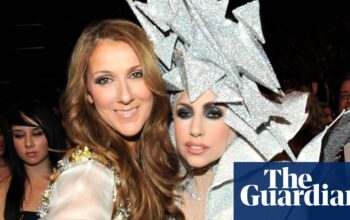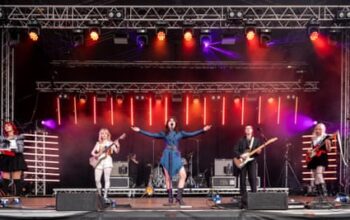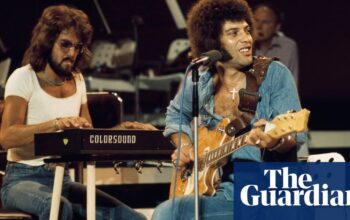‘A
The song says, “All around me are familiar faces / worn-out places, worn-out faces,” and a man wearing a large skirt dances to the beat on stage as Mad World plays in the auditorium. LoveTrain2020 is the latest performance by Emanuel Gat, a choreographer from Marseille, featuring music solely from Tears for Fears. While it may not be the typical choice for contemporary dance, other companies such as Birmingham Royal Ballet have performed to songs by Black Sabbath (and even Arthur Pita’s Björk Ballet and Marco Goecke’s Tori Amos dance piece), so why not?
Gat, who is now 54 years old, did not have any Tears for Fears albums during his teenage years living near Tel Aviv in the 1980s. He was more interested in progressive rock bands like Pink Floyd, Genesis, and Jethro Tull. However, he notes that Tears for Fears is a well-known band wherever they perform.
Gat has been choreographing for three decades, with his most notable pieces being set to classical and jazz music (he initially studied music and aspired to be a conductor). However, he had never incorporated popular music into his works until an algorithm introduced him to it. While on a walk with headphones on, he heard the song “Sowing the Seeds of Love” play, even though it wasn’t on his playlist. Surprised by how good the music was after not hearing it for years, Gat was intrigued by the lyrics, sound, and structure of the song.

Pop can be challenging to work with due to its strong identity and consistent rhythm. During my conversation with Gat, he demonstrated a 4/4 beat on the table, explaining that pop music can be overpowering and leave little room for creativity. In fact, he found it easier to choreograph to Pierre Boulez’s music than to Tears for Fears. Despite obtaining permission to use their tracks, Gat is unsure if band members Curt Smith and Roland Orzabal are even aware of it. “Obtaining the rights involves going through an agency and contacting the label, but the final step is sending a personal letter to the artist. Unfortunately, we did not receive a response,” he explains. “I suspect that the artist’s agent may have brushed it off, thinking, ‘Contemporary dance? Not worth our time.’ After all, there’s no financial gain for them.”
He has extended an invitation for Curt and Roland to come, but he is worried they may refuse and potentially revoke the granted rights if they are not satisfied with what they see.
I believe they would enjoy it. It is not what one would typically expect from dancing to popular music (although Orzabal himself showcases some impressive dance moves in the original Mad World video). The dancers make their first appearance to tracks from the 1983 album The Hurting, appearing as if they have raided a haberdashery, with layers of fabric resembling historical costumes and enhanced by dramatic lighting reminiscent of Caravaggio’s style. As the performance continues with Everybody Wants to Rule the World and Shout, the dancers are gradually stripped down to their underwear, posing in a 2D manner resembling bas-relief or hand-in-hand like Matisse’s famous dancers.

If you’ve only listened to the popular songs on the radio without paying much attention, you may be surprised to find that the music has a dark, eerie, and emotional quality. The dance is difficult to define and categorize. Gat is not satisfied with simply dancing to the beat; he believes that is too simple. He explains, “It’s so effective that it shuts your brain off as a viewer. You become passive. When I watch something like this, I feel like I’m being manipulated.” He desires for his dance to have a sense of ambiguity, rather than being too definitive.
Gat’s approach to creating dance involves setting tasks for dancers to improvise within a structured framework. He rejects the idea of choreographers imposing their own style and expecting dancers to simply imitate it. He finds this approach egotistical and believes that it creates a problematic dynamic where dancers are essentially competing to mimic the choreographer’s movements. Instead, Gat values the individual creativity and expression of each dancer.
Gat’s role as a choreographer involves arranging movements and relationships within specific time and space. Despite this seemingly simple definition, he views the studio as a miniature representation of the larger world with all its complexities and frameworks. He explains, “I gain insight into society by studying choreography. My focus is on individuals and groups, making it effortless to draw parallels between their behavior and that of society at large.”
The speaker states that economics deals with the management and distribution of resources. In the studio, the resources are represented by the creative decision-making process. The speaker can either make all the decisions and give instructions or share the responsibilities with others. They believe that the success of this system can be seen in the positive attitudes of those involved. However, they also recognize that in real life, it is not fair for a small percentage of individuals to have more resources than entire countries. This is why there is so much suffering in the world.
Gat explains that he places the dancers in an active role, allowing them to take ownership of their choices and ultimately become liberated. He then reflects on society and believes that this approach is the reason for its downfall. Essentially, he is striving to create a utopian world on stage for a brief period of time.
The LoveTrain2020 event will be taking place at Sadler’s Wells in London on November 17-18.
Source: theguardian.com


